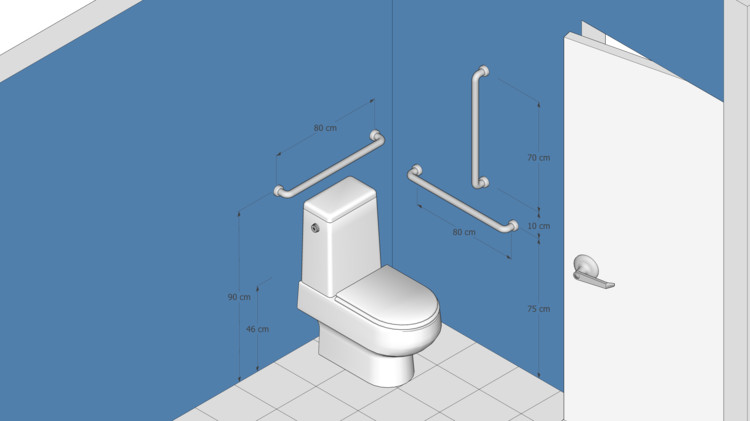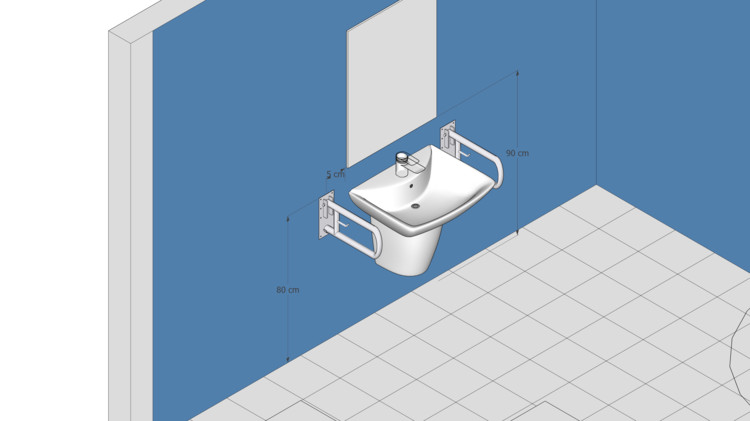
There exist frequent reports of toilet accidents, as they are often located in tight and slippery places. Although no one is immune to a slip after bathing, it is the elderly who suffer most from falls, and can often suffer serious injuries, sequelae, and functional limitations. Due to the natural reduction of reflexes and muscle mass, the higher the age group, the more prone to falls we become.
To provide more comfortable living conditions as users grow older, the environment must adapt to the new physical capabilities of its occupants. Making toilets safer is critical to reducing the risk of accidents and decreasing response time in the event of a fall. Here are some things to keep in mind when designing toilets for older people:
Affordable toilets that comply with universal design standards generally serve the demands of the elderly, who are considered a group of people with reduced mobility. Even if the elderly still have the ability to walk, it is important to consider wheelchair use and the possibility of a caregiver when sizing spaces. A well-designed and spacious wheelchair-accessible bathroom also improves circulation, preventing falls and injuries from bumping into something.

Bathroom Access
The first concern should be how the bathroom is able to be accessed. A clear path without barriers or loose objects such as rugs or shoes is essential to avoid tripping or disrupting traffic from a wheelchair. At night, adding light sources on the way to the bathroom, with well-located switches, is also vital for safety.

Doors
The bathroom door should be able to be opened easily and intuitively and be at least 80 centimeters wide. Lever knobs are simpler than those that require twisting the handle. Removing locks can make access easier if necessary for an emergency. It is also convenient for the door to slide or open for the same reasons.
Flooring

Due to water, soap, and other toiletries, it is common for floors to become slippery in bathrooms. It is therefore imperative that the floor is made of a non-slip material. All kinds of floors have non-slip options such as ceramics, cementitious boards, epoxy, and rubberized floors that can work well for bathrooms. Some experts suggest that bathrooms have contrasting colors, for example if the walls or the floor contrast with the sanitary ware, to avoid confusion for elderly people with reduced vision.
Rugs, if not suitable, can also be a major cause of accidents. Ideally, they should be rubberized where they touch the floor so that they have sufficient friction with the surface and never slip.
Toilets
Because of the reduction of muscle tone in the elderly, a higher toilet can ease the movement of sitting and especially getting up. Thus, it is recommended that toilets are a little higher than the conventional height, which can be done by "wedging" the existing toilet. They should end up being about 46 cm high. Of course, they should also be tightly attached to the floor or wall.

Grab Bars
Grab bars assist at the most critical times, such as when sitting on the toilet or at the shower stall entrance. Using accessories that are not suitable for the weight of the user, such as the towel bar, can be extremely dangerous. The bars should usually be aluminum or stainless steel and should be tightly secured to the wall. They are usually installed near the toilet and also the shower, between 1.10 and 1.30 meters high. If the bathroom is too large, it is preferred to install safety bars on the empty walls that lead to these two strategic points of the bathroom.
Faucets

Like doors, it is better to install lever taps or faucets with electric sensors, which are easier to handle than spherical knobs.
Shower box

The shower box should be at least 80 centimeters wide, while bathtubs should be avoided due to the difficulty of entry and exit. It is recommended to provide space for a second person, usually a caregiver, to assist the elderly when necessary. Similarly, it is suggested to provide an additional shower head to help facilitate this assistance. Another important element is a folding support stool, which should be about 46 cm above the floor.
Elderly Bathroom Alert System

Even when all these precautions are taken, it is always important to predict the worst possible scenario, such as an accident. Doorbells, alarms and emergency buttons are important in case the elderly person needs to signal a problem. They are often connected to telecare companies, who will quickly assess what precautions to take. It is important to place this device in a very accessible location near the floor so that it can be used even when there is no possibility of getting up. Another available solution is the installation of sensors in the rooms and in the occupant itself, using automation, as already discussed in this article.
It is important to mention that each country has standards for accessible bathroom dimensions and safety features, whether for wheelchair users or people with reduced mobility. The purpose of this article is to show you tips and points to consider when designing safe and comfortable bathrooms that will reduce the chances of unpleasant events.














